#ca. 1718
Text

▪︎Bacchus.
Date: ca. 1718-1719
Artist: Giovanni Antonio Pellegrini (Venice; 1675-1741)
Medium: Oil on canvas
#18th century decorative arts#18th century art#18th century#18th century painting#art#painting#history of art#art history#mythology#bacchus#Giovanni antonio Pellegrini#ca. 1718#ca. 1719
34 notes
·
View notes
Text

Meme, ca. 1718 (colorized)
#meme#created by yours truly#ofmd meme#ofmd#our flag means death meme#our flag means death#stede#stede bonnet#the real stede bonnet#pirates#history#history meme#1710s#1718#18th century
65 notes
·
View notes
Text

Jean Ranc (French, 1674-1735)
Infanta María Ana Victoria de Borbón, Spanish Infanta, Queen Consort of Portugal and the Algarves, (1718-1781), ca.1725
Museo Nacional del Prado, Madrid
#Jean Ranc#french art#spanish princess#infanta#infanta maria ana victoria de borbon#borbon#spanish infanta#queen#princess#european art#art#fine art#classical art#europe#european#oil painting#fine arts#europa#mediterranean#spanish#hispanic#latin#royal#noble#nobility#royalty#aristocrat#aristocracy#spanish aristocrat#spanish aristocracy
42 notes
·
View notes
Text
Esoterica

I° esposizione internazionale d'arte decorativa, Torino, 1902 (Collezione Soleri, Torino) | Leonardo Bistolfi (1859-1933, Italia) |

La Superbia (Mira qui come va senza ritegno la cecitade humana al cieco regno), 1679 (British Museum) | Giovanni Maria Mitelli (1634-1718, Italia)

Pornocratès - La dame au cochon, 1896 (Musée Félicien Rops, Namur, Belgium) | Félicien Rops (1833-1898, Belgium) et Albert Bertrand (1852-1912, France)

Los Proverbios, 1817-23 | Francisco Goya (1746-1828, España)

Surreal nude with candle - occult photo, 1950's |cph., Zoltán Glass (1903-1982, Hungary)

Jacobs Dream, 1805 | William Blake (1757-1827, England)

Carnevale | Italico Brass (1870-1943, Italia)

The joyous festival, 1906 ca. | Gaston La Touche (1854-1913, France)

Clouds, Lauterbrunnen Valley, 1901 | Charles Giron (1850-1914, Switzerland)

I cavalieri della nebbia (the knights of the fog), 1896 | Albert Welti

Fairies dances in the woods with faun on gramophone, 1925

Idolo nero (idole noire), 1903 | Frantisek Kupka (1871-1957, Czechia)

The path of silence, 1903 | Frantisek Kupka (1871-1957, Czechia)

Nymphs dancing to Pan's flute | Joseph Tomanek (1889-1974, Czechia - USA)

Oberon, Titania and Puck with fairies dancing, 1786 | William Blake (1757-1827, England)

s/t (w/t), 1975 (Sanok Museum, Poland) | Zdzisław Beksinki (1929-2005, Poland)

AA72, 1972 | Zdzisław Beksinki (1929-2005, Poland)

Dance on the beach, 1900-02 | Edvard Munch (1863.1944, Swedev)

Summer, 1890's | Thomas Wilmer Dewing (1851-1938, USA)

Summer evening, 1947 | Edward Hopper (1882-1967, USA)
6 notes
·
View notes
Text
Maria Gaetana Agnesi (1718-1799): A Very Short Biography
Maria Gaetana Agnesi was born in Milan, then the capital of a Duchy under Austrian rule, on 16 May 1718. She was the daughter of Pietro Agnesi (1690-1752), the scion of a family of wealthy merchants who traded in luxury textiles. At the age of five, Maria Gaetana was already known in her native city as a prodigy, well versed in languages, memorizing lengthy Latin speeches, and performing effortlessly in front of an audience in her family palazzo. Available descriptions of her skills may contain symbolic elements —for example, her alleged ability to speak seven languages fluently— but it is clear that the young girl was highly talented, and most intriguingly for her contemporaries, she would soon excel in the typically masculine art of philosophical disputation.
A booklet dated 1727 celebrated Agnesi's wit and the female intellect through a collection of poetry composed within a circle of family friends, and included a Latin oration in defense of the right of women to pursue any kind of knowledge. That oration had been written in Italian by one of Agnesi's tutors, and she had translated and memorized it as part of her studies. In the following years she studied natural philosophy and mathematics with prominent local scholars. Her studies were interrupted in the early 1730s by a mysterious and persistent malady, coincident with a period of repeated performances, the departure of her favorite tutor, and the death of her mother. Her "convulsions" eluded any diagnosis or treatment until about 1733, when she apparently recovered and returned to her studies. Her healing was attributed to the direct intercession of Saint Cajetan (San Gaetano), for whom the family had a particular devotion, as evidenced by her name, Maria Gaetana. Saint Cajetan was the founder of the Theatine order, to which Maria Gaetana kept a lifelong, profound spiritual connection.
In 1738, aged twenty, Agnesi concluded her studies with the publication of her thesis, under the title Philosophical Propositions (Propositiones philosophicae), thus mimicking the academic path of male students in contemporary colleges. By this time she had achieved the status of a minor celebrity in northern Italy and was the protagonist of the conversazione (literally, "conversation") that met regularly at palazzo Agnesi. A year later, at the height of her career as a filosofessa (woman philosopher), Agnesi expressed the desire to abandon the very public life, in which she could dedicate herself entirely to the study of mathematics, as well as to charitable activities and devotional practices.
After initial resistance, Pietro eventually accepted his daughter's requests. On her part, she promised she would still participate in the conversazione, although only sporadically. The following decade of intense mathematical study culminated in the publication of the Analytical Institutions (Instituzioni analitiche), a remarkable introduction to the new techniques of differential and integral calculus "for the Italian youth" and the first book of mathematics to be authored by a woman. Institutions was well received in Italy and was later translated into French and English. In the aftermath of its publication, Agnesi was invited to join various literary and scientific academies, and in 1750 she was offered an honorary lectureship in mathematics at the University of Bologna, then under the control of the pontifical government. However, she did not accept the position, considering her work in mathematics concluded with the Institutions.
Pietro's sudden death in 1752 made it possible for Agnesi to cut her last ties with the world of the conversazioni, give up her wealth and inheritance rights, and devote the rest of her life to charitable activities - such as teaching children in parish churches and assisting infirm women at the Ca' Granda, the ancient city hospital. In 1771 the archbishop of Milan, Giuseppe Pozzobonelli (1696-1783), offered Agnesi the directorship of the female section of the Pio Albergo Trivulzio, a new institution created to house invalid and chronically ill patients from the lower urban social strata.
She took up the job with her usual determination, steering the Albergo through the jurisdictional conflicts that characterized the reformist age and the turbulent close of the century. Maria Gaetana Agnesi died of pneumonia in the rooms of the Albergo on 9 January 1799. Milan was under French occupation at the time, and she died a citizen of the Repubblica Cisalpina. All forms of public ceremony had been prohibited to avoid confrontations between French troops and the local population. Agnesi was buried hurriedly in an unmarked mass grave outside the city walls, together with fifteen other women from the Albergo.
- Massimo Mazzotti ("Maria Gaetana Agnesi: Science and Mysticism")

5 notes
·
View notes
Text
Joseph Aloys Schmittbaur (1718-1809) - Symphony in B-flat Major (ca. 1770), I. Allegro assai. Performed by Kirstin Kares/Hof-Capelle Carlsruhe on period instruments.
#joseph aloys schmittbaur#classical music#classicism#rococo#orchestra#period performance#period instruments#rarely performed composers#sinfonia#symphony#strings#string orchestra
23 notes
·
View notes
Text

Antoine Watteau 1684-1721
Head of a Man ca.1718
The Metropolitan Museum of Art, NYC
6 notes
·
View notes
Photo

Head of a Man. ca. 1718. Credit line: Rogers Fund, 1937 https://www.metmuseum.org/art/collection/search/334650
#aesthetic#art#abstract art#art museum#art history#The Metropolitan Museum of Art#museum#museum photography#museum aesthetic#dark academia
5 notes
·
View notes
Text
More early post-Louis XIV fashion -
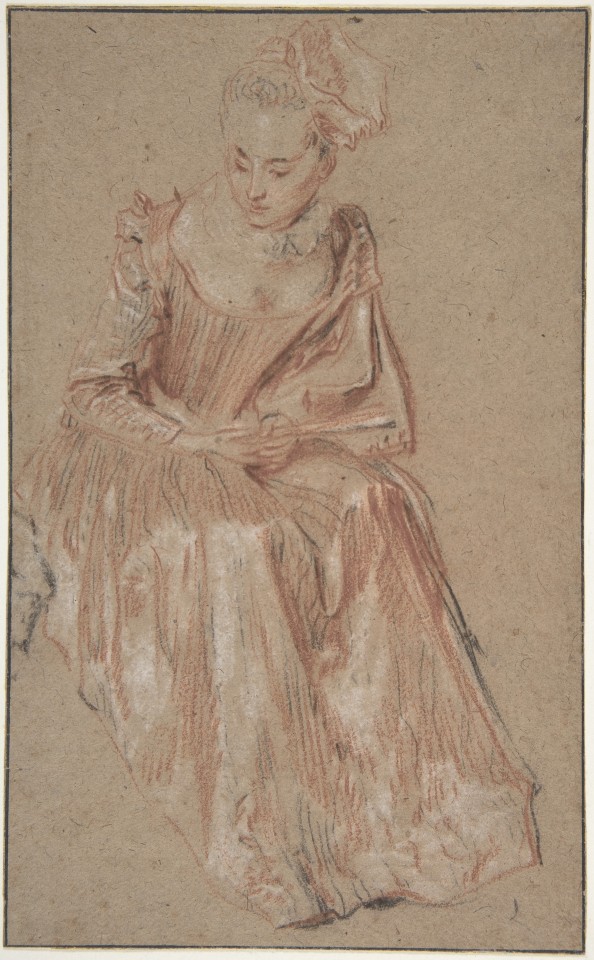
ca. 1717 Seated woman holding a fan by Antoine Watteau (Metropolitan Museum of Aty - New York City, New York, USA). From their Web site 2400X3882.
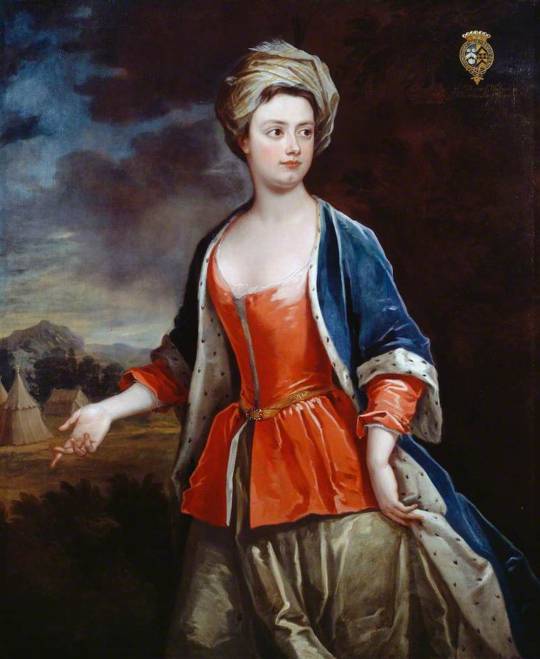
ca. 1718 Dorothy Walpole, Viscountess Townshend by Charles Jervas (Dulwich Picture Gallery - London, UK). From the-athenaeum.org; enlarged by half 1161X1416.

Probably Dorothy, Viscountess Townshend, by Charles Jervas (National Portrait Gallery - London, UK). From Wikimedia 2400X3161.

ca. 1719 Maria Clementina Sobieska by ? (National Portrait Gallery - London, UK). From Wikimedia; fixed spots & some cracks w Pshop 2076X2623.
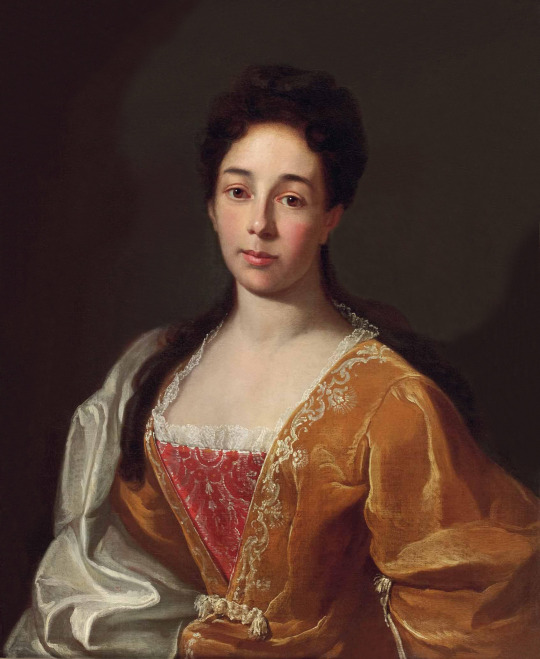
1719 Anna Catharina Herport by Johann Rudolf Huber (private collection). From Wikimedia; fixed spots w Pshop 1693X2067.
#1700s fashion#Louis XV fashion#Louis XIV fashion#Rococo fashion#Georgian fashion#Pierre Mignard#lace bertha#lace ruffled sleeves#lace lappets#Antoine Watteau#corset#Charles Jervas#turban#full skirt#girdle#lace modesty piece#scoop neckline#hair jewelry#Johann Rudolf Huber
5 notes
·
View notes
Note
Sorry it took me so long, i got sick and then forgot but here are some dances we do!
This is a very simple one but it’s fun and you can add lot’s of flourishes, it’s called the chapelloise (often danced at renfaires but not actually medieval, originated ca. 1900): https://youtu.be/jdu-4ciS-Uk
This is one of those annoying french ones, it’s not too complicated but I have terrible coordination (called An Dro): https://youtu.be/R7LHVOv-8iY
This is one of my favourites (featuring a ton of spinning that does get slightly exhausting after a bit), Puck’s Deceit (english country dance, ca. 1651): https://youtu.be/ln9LmO5t_3Y
Collier’s Daughter (I apologize that this list is getting long, we do so many dances and it is so hard to pick favourites, it’ll be over soon I promise), english country dance ca. 1718: https://youtu.be/PNt1APkZ_hA
Scales of Justice, it’s a modern dance (2006), but it’s fun! it plays with different speeds and turning only 3/4 of a full turn is a lot harder than you’d expect https://youtu.be/ub6ugFstSlo
Ooooh nice!!! I will watch these soon, thank you very very much! They sound epically fun xD
#asked and answered#and no worries about time fr i am terrible at remembering things so i get it#wedefyauguryy#dancing#links
1 note
·
View note
Text
¿Gente del Libro Gordo?
San Mateo Evangelista por Camillo Rusconi, ca. 1718.

#¿Gente del Libro Gordo?#¿Esta es la imagen y algunos datos (O no) la “Historia” la pones tú? ¡La tuya! ¿Lo harás...?#Cuando la escultura es cultura
2 notes
·
View notes
Text
1. Cultura Occidental Europea Moderna
1.1. El romanç de la princesa bastarda i el segador
Cançó de sega de tradició oral, d'origen medieval.
youtube
1.2. Leonardo da Vinci (1452-1519)
Nascut tal dia com avui (15 d'abril de 1452) il·legítimament per Caterina, una dona del poble, i Piero da Vinci, notari i ambaixador toscà. El biògraf Walter Isaacson descriu Leonardo da Vinci com un geni autodidacta i curiós, la condició de bastard del qual va ser una benedicció que li va permetre seguir les seves pròpies passions sense la influència d'idees antiquades.

L'home de Vitruvi. Leonardo da Vinci (1492). Tinta sobre paper.
Tot i ser esquerrà, homosexual, herètic i vegetarià distret, el seu rebuig primerenc del sistema educatiu convencional i la seva residència a Florència el van exposar a noves idees i el van encoratjar a pensar de manera diferent. Isaacson destaca l'habilitat de Da Vinci per unir art i tècnica, semblant a la d'Steve Jobs amb l'iPad, i assenyala que la seva creença en la connexió entre la bellesa de la natura i l'art va ser clau per al seu èxit. Encara que Leonardo va lluitar amb la depressió i la por al fracàs, el seu llegat es caracteritza pel seu mestratge en obres tant artístiques com científiques, encara que moltes van quedar inconcluses.
1.3. Ferran Colom i l'incipient món modern del Renaixement catòlic
Fill il·legítim de Cristòfor Colom i una seva amant, Ferran va ser clau tant per fer justícia al seu pare en els famosos plets colombins contra la Corona Espanyola com per escriure les seves memòries.

Portada de la primera edició de les memòries de Ferran Colom Historie del Signore Don Fernando Colombo (Venècia, 1571).
Ferran Colom va fundar la Biblioteca Colombina, incloent-hi una col·lecció exhaustiva de les obres d'un altre bastard destacat del Renaixement europeu: Erasme de Rotterdam, qui va ser fill bastard de capellà catòlic. En parla exhaustivament el text Erasmo en la biblioteca de Hernando Colón, trobat a la Biblioteca digital de la UOC.


1.4. Cant alla bastarda
Pràctica de cant popular al Vaticà que consistia en fer un collage amb les diverses veus d'una composició polifònica a quatre, cinc o sis veus per tal d'interpretar-les només per dos intèrprets. En Marco Scavazza ho explica prou bé, en aquest vídeo presentació del seu disc 'Cantar bastardo' (2011):
youtube
2. Cultura Occidental Europea Contemporània
2.1. Francisco de Goya: La Filiación (1797-1799)
A l'arxiu en línia del Museo Nacional del Prado trobo aquest interessant gravat de Goya, número 57 de la sèrie Los Caprichos. L'actitud lasciva d'una núvia, que es casa ataviada amb una màscara de guineu, suggereix les intencions paleses de ser infidel al marit. No cal dir que aquesta sol ser la llavor de tota filiació il·legítima...

En tot cas, val a dir que en el meu cas va ser així, doncs vaig ser fruit d'una relació extramatrimonial de la meva mare amb un company de la seva feina com a oficinista a Freixenet...
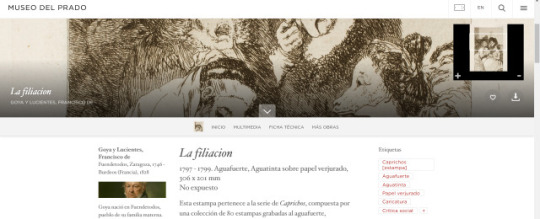
2.2. Filiació il·legítima a l'Anglaterra victoriana
L'oli The Outcast (1851) del pintor anglès Richard Redgrave (1804-1888) ens mostra un dramatisme a l'hora de tractar el tema de la filiació il·legítima molt allunyat de l'alegria amb què notaris i homes de món afrontaven el mateix fet segles abans, tal com hem vist als casos de Da Vinci o Colom.

Richard Redgrave The Outcast (1851). Pintura a l'oli.
El físic William Hunter (1718-1783) ja va recollir, un segle abans, evidències sobre els trastorns mentals que tenien les mares de fills bastards que, sota una gran pressió social, cometien infanticidi per tal de no tacar la seva imatge pública. Podeu llegir On the uncertainty of the signs of murder in the case of bastard children (publicat pòstumament el 1808) al següent enllaç trobat a través d'una cerca a la Biblioteca digital de la UOC:

2.4. Barcellona Ferita Aperta
Mónica Uriel signa aquest documental del 2015 que presenta la trobada entre la filla d'un pilot italià que va bombardejar Barcelona durant la Guerra Civil, el març de 1938, i el fill d'un home mort a causa d'aquells bombardejos.

M'interessa incloure aquest referent per diversos motius. Per una banda per obrir un espai de solidaritat entre bastards i orfes, amb la reflexió sobre els paral·lelismes que poden seguir les seves vides. Després, vull apropar-me a uns fets històrics que va generar la bastardització de tots aquells espanyols i espanyoles que van perdre la guerra i no volien combregar amb el nou status quo feixista que va instaurar-se un cop la Segona República va perdre l'enfrontament. En tercer lloc, perquè obre un espai de reconciliació, única sortida positiva per a les situacions de filiació obstruïda a causa de violència.
Barcellona ferita aperta, que he trobat a través dels Recursos per a projectes de la UOC, està disponible en línia i en obert a Vimeo:
2.5. Op:L Bastards
Op:L Bastards és un trio electrònic d'Hèlsinki que es va formar el 1996 i fan música innovadora mirant alhora a banda i banda del nou mil·leni. Els he conegut gràcies a una cerca a l'arxiu del MoMA de Nova York, on van actuar en el marc dins del PS1's, és a dir, la programació de música a l'aire lliure del cèlebre museu, el 23 d'agost del 2008, ja gairebé al final del seu recorregut com a grup (1998-2009).
En aquests enllaços a la música de "The Job" he trobat inspiració per a la producció de música per al projecte "El Final del Camino" que estic construint a partir de la llavor de l'univers del bastard. La seva música electroacústica generada a trio per nombrosos sintetitzadors i instruments com panderos acompanya veus cantades i altres sons humans (rialles, xiulets, sons guturals) en estructures harmòniques complexes.
youtube
2.6. Julian Jeweil: Bastard (EP)
Diversos estils musicals com el techno o el metal reneguen de la seva filiació artística de la cultura musical immediatament anterior, generant un canvi estètic trencador respecte als seus "pares naturals" dins la disciplina.
Com que sóc productor de música techno, sota el nom de DJ Leiermann, i aquesta no faltarà a 'El Final del Camino', incloc en Julian Jeweil dins aquest recull de creadors i creacions bastardes amb el seu EP titulat 'Bastard', publicat per Plus 8 Records el 2012.
youtube
2.7. Cultura Bastarda! de Mirko Tobias Schäfer
Amsterdam University Press va publicar el 2011 aquest puntillista estudi de Mirko Tobias Schäfer, professor i investigador en Societat Digital, sobre com la participació de l'usuari transforma la producció cultural.

Per a la meva investigació, em centro en la lectura del capítol 4, homònim al del llibre, on s'exposa com la creativitat dels usuaris de consoles de videojocs com l'Xbox són capaços de modificar-les de manera activa. Schäfer posa de relleu la importància dels usuaris en la co-creació i evolució dels productes industrials culturals, que en el cas de l'Xbox va generar el naixement d'una consola alternativa fruit de la seva col·laboració amb hackers. La Xbox bastarda funciona amb tecnologia Linux per oferir totes la funcions de joc i desenvolupament "capades" a la versió oficial de Microsoft.

Mirko Tobias Schäfer
El text íntegre de Bastard culture! està disponible en línia a través de la Biblioteca digital de la UOC:

2.8. Bastard or Playmate?: Filiació bastarda de les arts escèniques al tercer mil·leni
Assaig col·lectiu, editat per Robrecht Vanderbeeken, Christel Stalpaert, David Depestel i Boris Debackere i també publicat per l'Amsterdam University Press. Al text es reflexiona sobre l'elevat grau de mutabilitat observable al subsector cultural de les arts escèniques al segle XXI. La constant aparició de nous dispositius i mitjans creatius reconfigura constantment les connexions entre mitjans expressius, oferint nous dispositius que, alhora que eixamplen els límits de la creativitat, n'instauren de nous.
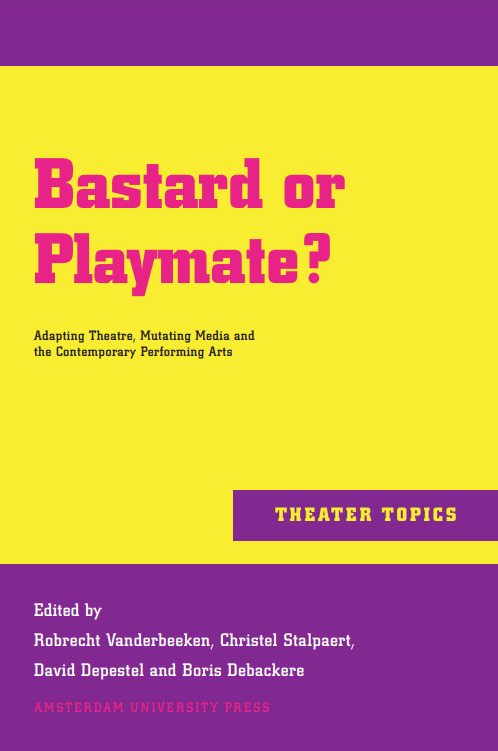
a tesi dels autors és que els productors culturals han passat a buscar la innovació i la polèmica de manera creixent al llarg del segle XX com a conseqüència d'un entorn social marcat per "la globalització, la migració, el transculturalisme, la fi dels grans relats, la desaparició dels valors tradicionals i l'augment abrupte de l'individualisme" (p. 10).
Avui els productors de cultura investiguen els límits i les possibilitats dels mitjans que utilitzen, tot intervenint en la seva creació, millora i la mutilació.
El text íntegre, que també he trobat fent recerca a la Biblioteca digital de la UOC, està disponible en línia:

Com a extraconnexió relacionada amb aquest text, una experiència professional pròpia. Bastard of Playmate? analitza el context de les arts escèniques des dels Països Baixos, on participo com a performer en un projecte a cavall entre l'òpera i la performance titulat Madrigals.
vimeo
Documental MADRIGALS | behind the scenes sobre el procés de creació de l'obra
Puc donar fe de fins a quin punt el llenguatge escènic del neerlandès Benjamin Abel Meirhaeghe, director del projecte, és subvertit tant en la forma com en el fons, incloent un procés de creació de l'obra en què la psicologia dels intèrprets i les seves decisions creatives són troncals per a la definició de la peça d'art en viu.
La pàgina web de Madrigals és una cova de les meravelles on poden trobar-se tota mena de tresors creatius:
#uoc#graudarts#project#proyecto#projecte#diari del projecte i#projecte i#inventari interior#el final del camino#challenge 2#reto 2#repte 2#challenge#reto#repte#símbol#símbolo#symbol#bastard#constel·lacions bastardes
0 notes
Text

Jan Griffier, attributed to (Dutch, 1648–1718)
Winter Landscape, ca.1680-1718
The Cleveland Museum of Art
#dutch#flemish art#jan griffier#art#fine art#european art#classical art#europe#european#oil painting#fine arts#europa#winter landscape#1600s#1700s#traditional art#landscape art#landscape#winter#christmas#medieval#castle#dutch art
33 notes
·
View notes
Text

Rug Masters Cleaning and Repair, Oriental Rugs
Rug Masters Cleaning and Repair is a company that specializes in rug cleaning and repair in the Berkeley area. We offer a variety of services, including cleaning, repair, and stain removal for all types of rugs, including Oriental rugs, Persian rugs, and area rugs. We have been serving the Berkeley area for over 29 years and have a team of experts who are knowledgeable about all aspects of rug care. You can find more information about Rug Masters Cleaning and Repair on our website at https://www.rugmasterscleaning.com/ or by calling us at 510-704-0460.
Address: 1718 University Ave, Berkeley, CA 94703, USA
Phone: 510-704-0460
Website: http://www.rugmasterscleaning.com
0 notes
Text
Mien Bao House, 1718 N Milpitas Blvd, Milpitas, CA 95035

Mien Bao House replaced another Chinese bakery. I went late in the evening and they were sold out of all their baked buns and egg tarts. They still had cake slices, cookies, cupcakes, steamed baos, frozen dumplings and buns, muffins, and coconut tarts.
The refrigerated cake rolls looked terrible. The frosting was cracked and dried looking. I should have walked out but most Chinese bakeries had closed and MBH was actually open in the evening.
Fried sesame ball: Thick, chewy glutinous rice exterior, red bean filling inside was a strange shade of pink and didn’t have much red bean flavor, served cold. It was below average.
Big chicken bun ($5): Truly meal size with Chinese sausage, a hard-boiled egg, wood ear mushrooms, and chicken pieces. The bun was kept in a warm and probably steaming for hours. The bun was soggy on the bottom but the filling tasted decent. The exterior was thick, sweet, and mushy.
Honey cookies: just okay, not much flavor
Japanese cheesecake: Fluffy, light, moist. Not bad but mushy on the bottom.
Mien Bao House is in a busy shopping area. Parking could be difficult. They also had lots of deals, including a free Japanese cheesecake with a purchase of $20 or more. Prices are very reasonable.
3 out of 5 stars
By Lolia S.
#Mian Bao House#Milpitas#Chinese bakery#cake rolls#Chinese baked buns#cookies#cupcakes#frozen dumplings#Chinese steamed bao#egg tarts
0 notes
Text
Anna Belfrage Times of Turmoil #AmericanColonialHistory #timetravel #historicalfiction #historicalromance @abelfrageauthor @cathiedunn

FEATURED AUTHOR: ANNA BELFRAGE
I am delighted to welcome Anna Belfrage as the featured author in The Coffee Pot Book Club Blog Tour being held between October 24th — November 14th, 2023. She is the author of the Historical Fiction / Time Travel Romance, Times of Turmoil, released by Timelight Press on September 29th, 2023 (382 pages)
Below are highlights of Times of Turmoil, Anna Belfrage's author bio, and her fascinating post about indentured servants in Colonial America.
Tour Schedule Page: https://thecoffeepotbookclub.blogspot.com/2023/09/blog-tour-times-of-turmoil-by-anna-belfrage.html
HIGHLIGHTS: TIMES OF TURMOIL
Times of Turmoil
by Anna Belfrage
Blurb:
It is 1718 and Duncan Melville and his time traveller wife, Erin, are concentrating on building a peaceful existence for themselves and their twin daughters. Difficult to do, when they are beleaguered by enemies.
Erin Melville is not about to stand to the side and watch as a child is abused—which is how she makes deadly enemies of Hyland Nelson and his family.
Then there’s that ghost from their past, Armand Joseph Chardon, a person they were certain was dead. Apparently not. Monsieur Chardon wants revenge and his sons are tasked with making Duncan—and his wife—pay.
Things aren’t helped by the arrival of Duncan’s cousin, fleeing her abusive husband. Or the reappearance of Nicholas Farrell in their lives, as much of a warped bully now as he was when he almost beat Duncan to death years ago. Plus, their safety is constantly threatened as Erin is a woman of colour in a time and place where that could mean ostracism, enslavement or even death.
Will Duncan and Erin ever achieve their simple wish – to live and love free from fear of those who wish to destroy them?
Buy Links:
This title is available on #KindleUnlimited.
Universal link: https://myBook.to/ToTABG
Amazon US: https://www.amazon.com/dp/B0CJ7FYQVL
Amazon UK: https://www.amazon.co.uk/dp/B0CJ7FYQVL
Amazon CA: https://www.amazon.ca/dp/B0CJ7FYQVL
Amazon AU: https://www.amazon.com.au/dp/B0CJ7FYQVL
AUTHOR BIO: ANNA BELFRAGE
Had Anna been allowed to choose, she’d have become a time-traveller. As this was impossible, she became a financial professional with two absorbing interests: history and writing. Anna has authored the acclaimed time travelling series The Graham Saga, set in 17th century Scotland and Maryland, as well as the equally acclaimed medieval series The King’s Greatest Enemy which is set in 14th century England.
Anna has also published The Wanderer, a fast-paced contemporary romantic suspense trilogy with paranormal and time-slip ingredients.
More recently, Anna has been hard at work with her Castilian series. The first book, His Castilian Hawk, published in 2020, is set against the complications of Edward I’s invasion of Wales. His Castilian Hawk is a story of loyalty, integrity—and love. In the second instalment, The Castilian Pomegranate, we travel with the protagonists to the complex political world of medieval Spain, while the third, Her Castilian Heart, finds our protagonists back in England—not necessarily any safer than the wilds of Spain! The fourth book, Their Castilian Orphan, is scheduled for early 2024.
Anna has recently released Times of Turmoil, the sequel to her 2021 release, The Whirlpools of Time. Here she returns to the world of time travel. Where The Whirlpools of Time had Duncan and the somewhat reluctant time-traveller Erin navigating the complexities of the first Jacobean rebellion in Scotland, in Times of Turmoil our protagonists are in Colonial Pennsylvania, hoping for a peaceful existence. Not about to happen—not in one of Anna’s books!
All of Anna’s books have been awarded the IndieBRAG Medallion, she has several Historical Novel Society Editor’s Choices, and one of her books won the HNS Indie Award in 2015. She is also the proud recipient of various Reader’s Favorite medals as well as having won various Gold, Silver, and Bronze Coffee Pot Book Club awards.
Find out more about Anna, her books and enjoy her eclectic historical blog on her website, www.annabelfrage.com
Author Links:
Website: www.annabelfrage.com
Twitter: https://twitter.com/abelfrageauthor
Facebook: https://www.facebook.com/annabelfrageauthor
Instagram: https://instagram.com/annabelfrageauthor
Book Bub: https://www.bookbub.com/profile/anna-belfrage
Amazon Author Page: http://Author.to/ABG or http://amazon.com/author/anna_belfrage
Goodreads: https://www.goodreads.com/author/show/6449528.Anna_Belfrage
POST: INDENTURED SERVANTS IN COLONIAL AMERICA
In 1681, William Penn sailed across the ocean to found his colony, Pennsylvania. Armed with a royal charter and with a host of enthusiastic Quaker colonists, Penn’s ambition was to create something of a utopian society, as evidenced by the conserved plans for Philadelphia, a town that was to be clean and spacious, ensuring the health of its inhabitants.
William Penn was a Quaker, and most Quakers had firsthand experience of discrimination and persecution, none of which would ever be a problem in the fair colony of Pennsylvania. The Quakers also believed in equality. One of the reasons they were often thrown in jail was because they refused to address anyone with anything but “thou”. When faced with someone higher up the societal scale, one should use “you” – a bit like in French, where “tu” indicates familiarity and equality, “vous” respect. The Quakers insisted on “thou”, no matter if talking to their neighbour or the king. (Not that all that many Quakers ever spoke to the king, but still)
As a religious movement that believed in everyone’s equal value no matter gender, Quakers had—at least in theory—a problem with slavery. However, upon finally reaching their new colony, it soon became apparent that unless they found labour—preferably cheap labour—colonising all this new land would be almost impossible.
There was an established solution to the labour shortage problem, namely the practise of indentureship. This had been around for centuries. In essence, it was a contract whereby one person voluntarily entered the service of another person for a stipulated period of time. In general, any payments for the service were paid out in arrears, which meant an indentured servant who absconded could not claim on his back pay.
By the late 17th century, indentured servants had been around for almost a century in the New World. Initially, many came voluntarily, pledging themselves to work for seven years or so in return for getting a grant of land after their term of service was up. Thing was, the demand for new indentures exceeded the supply, which was how people were sent over without their consent, deported as it were. An efficient way of ridding the homeland of unwanted elements while also ensuring cheap labour for the colonists.
Whether forced or voluntary, the life of an indentured servant was no walk in the park. For a woman, there was the constant risk of being raped – these were societies with a chronic shortage of women – and should she become pregnant her term of service would be extended. The men ended up in the fields, disposable beasts of burden who were often worked until they dropped.
A disobedient (or “wilful”) servant was punished – in some cases so severely as to permanently maim the servant. Trying to run away was a serious offence that could lead to beating so brutal the person in question died, and on top of this the reluctant immigrants had to cope with food shortages and unknown ailments. On average, four out of ten indentured servants died before their terms of service was up. I have written at length about the plight of indentured servants in Like Chaff in the Wind, where my protagonist, Matthew Graham, effectively ends up as a mistreated beast of burden.
Times of Turmoil, however, is set more than fifty years later than Like Chaff in the Wind. Slavery had to a large extent replaced indentureship as the backbone of the economy in colonies like Maryland and Virginia, but in Pennsylvania indentureship still prevailed, albeit that some Quakers were beginning to reassess their take on slavery. Penn himself came to advocate slavery, saying that if you bought a slave you had a servant for life, which was a good thing. Hmm . . .
In Times of Turmoil, I have two indentured servants who play significant parts. One is Hans, the silent and enigmatic German indenture who is treated almost as family by Duncan and Erin Melville. Hans has lost everything he ever had back home and is determined to build a new life far from his past. He is also very anti-violence, having been a reluctant witness to the ravages of war.
Duncan came home to upheaval. Tim was sporting bruises and welts, there was a dead man wrapped in sacking in one of his sheds, and his wife . . . He suppressed the rage that lived inside of him, a snarling thing that growled and snapped whenever he caught sight of Erin’s swollen and bruised face. She looked as if she’d not slept a wink since the incident, and Mrs Andersson hovered round her like a worried mother hen. Only Hans seemed his normal, unruffled self, explaining tersely what had happened.
“Caleb will say you shot his father,” Duncan said with a sigh.
Hans actually smiled. “Ja. But with this, I shoot no one.” He handed over his pistol, and Duncan almost laughed. The flint was missing.
“Giles and Sivert will testify. Keine flint, ja? Never.”
“Then why carry it?” Duncan asked.
“People see what they want to see. A man pointing a pistol is an armed man.” Hans shrugged. “I have enough of killing.”
The other indentured servant is Tim. Some of the most vulnerable indentured servants were the children. Because they were so young—and therefore rather useless to begin with—they could be indentured for up to twenty years so as to recoup on the cost of transportation and bed and board. Tim is twelve when my Erin intercedes to save him from yet another brutal beating. Years of mistreatment have rendered him almost mute, and he flinches at any touch, having been conditioned to expect only pain. Sadly, in real life there were many Tims, lost boys and girls who had no one in their corner. No one. Tim, therefore, is lucky. Because once Erin had saved him, she had no intention of ever letting anyone hurt him again. A happily ever after to that particular indenture story—but then, I am partial to happily ever afters!
Instagram Handle: @thecoffeepotbookclub
Read the full article
0 notes